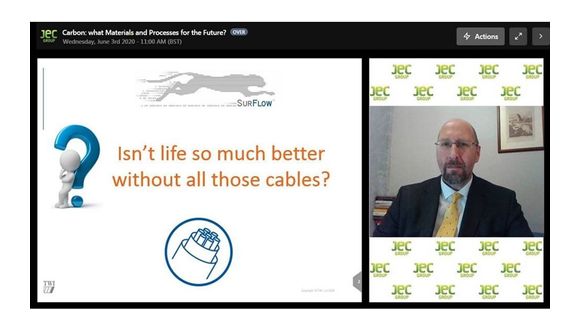Thu, 04 June, 2020
TWI’s advanced composites expert, Chris Worrall, gave a presentation on 3 June at the JEC World 2020 Web Conference as part of the session on ‘Carbon: Materials and Processes for the Future.’
Chris Worrall is a consultant at TWI, responsible for delivering composites joining, manufacture, processing and testing services to Members, both directly and through public funded projects. His 35 years of composites expertise covers composite-metal joining, thermoplastic composite welding, microstructure characterisation, mechanical testing of composite materials, finite element analysis of composites, design of composite structures and manufacturing technology for composite materials.
The title of Chris’ talk was, ‘SurFlow: Future Composite Data Highways,’ where he provided details of the data transfer technology.
About SurFlowTM
A breakthrough at TWI led to the creation of data transfer technology that can be seamlessly incorporated into composite materials to create a high capacity, resilient data transfer network.
SurFlow™ technology uses electromagnetic surface waves to transmit data directly through composite structures. Described as ‘the future of composite data highways,’ SurFlow™ technology removes the need for wires or fibre optics by passing data through the composite structure itself.
By turning a composite into a ‘smart’ material, the technology integrates a data network into a component’s physical structure. The system is capable of transmitting data at up to 3Gbps and can continue to function even if the composite part suffers damage. The frequency range that has been tested is 2-60GHz, depending on the industrial application.
Potential applications for smart composites exist throughout industry in almost every sector. For instance, in the automotive sector, where use of composites is now extending beyond high-end applications, the technology could significantly reduce the complexity of a vehicle’s internal communications network. In robotics, the technology could be used to enable communication throughout a robotic system without the use of wires. In consumer electronics, the technology would allow a device to connect instantly to a network simply by making contact with the composite’s surface, with no need to plug anything in or detect and connect to a wireless network.
Other uses being explored include proximity sensing and real-time composite monitoring, whereby subtle changes in the waveform allow any damage to a smart composite component to be identified immediately.
More information about the webinar where Chris gave his presentation can be found here.
